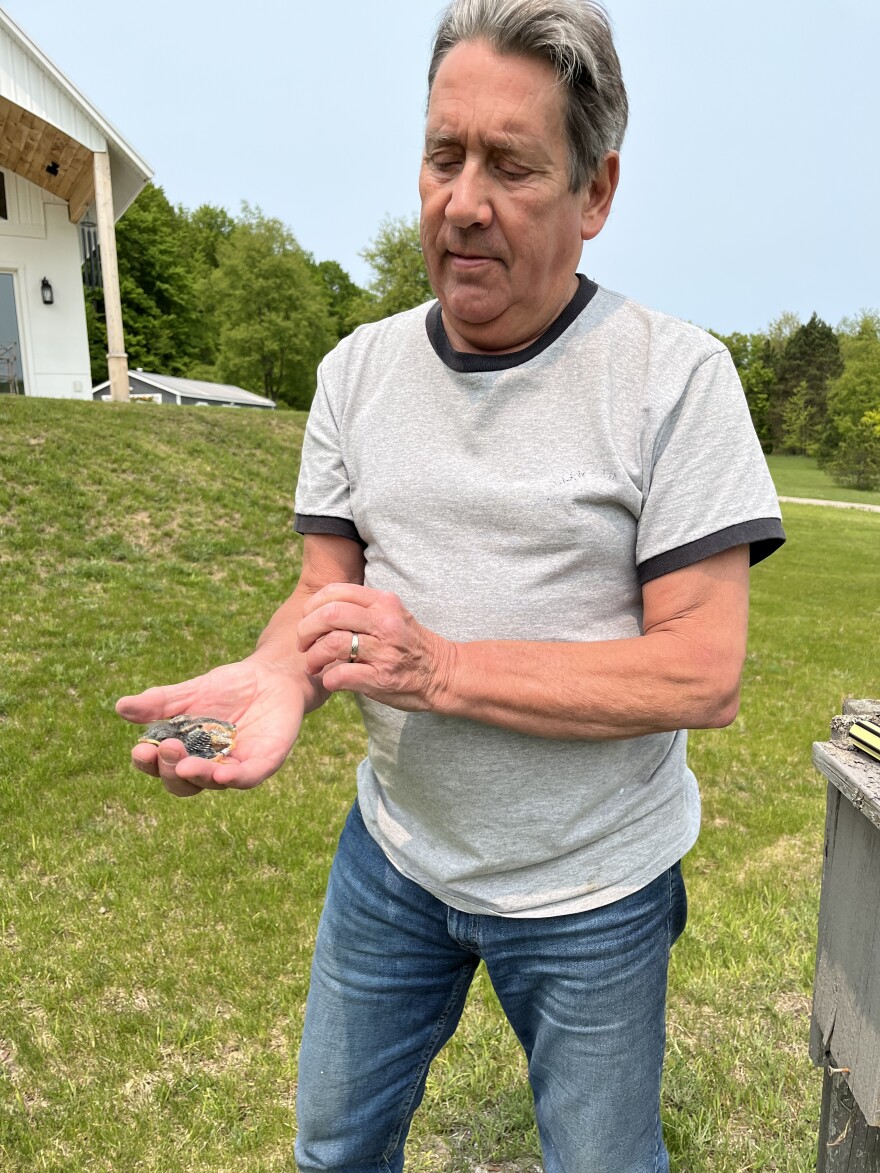Bluebird eggs are hatching all over Michigan this spring, and this week, we met a man who's spending the season housing and banding the birds.
GREG MILLER, BLUEBIRD LANDLORD
Greg Miller maintains dozens of nesting boxes for bluebirds across a 20-mile stretch of Benzie County.
"Right now I'm working with 47 boxes out there. Most are on private property that I've gotten permission from landowners to put them on and some are on state land," Miller says.
Miller also bands the birds. In fact, in the past 10 years, he's banded 20 percent of all the bluebirds banded in Michigan.
The data acquired from the bands aids research on bird behavior, migration patterns, lifespan, disease and habitat threats.
Miller's not new to banding — he started 50 years ago when as a student at Michigan State University.
"I met a fella named Phil, and he asked if I'd like to come along and see how he bands birds. I thought it sounded interesting, so I tagged along with him and he taught me all the ins and outs of bird banding," he says.
Bird banding permits are closely regulated and hard to come by, but Miller completed the required exams and received a master bird banding permit in 1972.
Miller takes us on a tour of his bluebird boxes. The first one we visit houses three babies, called nestlings, and two unhatched eggs.
He pops a numbered band onto the baby bird's left leg and lightly closes it with a special pair of pliers.
"That’s got a unique number on it. I received these from the banding lab. I'm responsible for these particular bird bands. So at the end of the season, I fill out a report online and record all the data that we have to record," he says.

At the next bluebird box we visited, Miller is excited to see five babies in the nest.
"Oh my god. Make that six. That's a big brood. That’s a real big brood," he says.
He places the six nestlings in a Tupperware sandwich container and gently picks up one bird at a time.
"They don't really know what's going on. This is their first glimpse of the world," he says.
He squeezes the small, metal band onto the baby bird’s leg.
"And we're gonna put them back. I just place them back in there carefully. Good luck guys. We'll see you again someday," Miller tells the birds. "I get along pretty well with the bluebirds here. I don't know if they really know me or not. But they've heard of me, I'm sure."
Miller has banded nearly 8,000 baby bluebirds and has never had an adult abandon a nest.
Back in the car, he records the nest name, number of birds, band numbers and a return date to check on the nest.
"I'll come back in about 10 days, 11 days, and that box should be empty. And we'll clean it out and hope for another brood," he says.
He’ll send the data collected to the Bird Banding Laboratory in Laurel, Maryland. If someone finds one of the birds he banded, Greg is notified by the lab.
"Somebody found one of my birds down in Carthage, Mississippi, which is in the center of the state. So I guess we could determine that that may say something about where our birds go in the wintertime, and that’s a direct line south of us," he says.
Greg says bluebirds return to nest within seven miles from where they were born.
To see Greg’s bluebird boxes, start at Crystal Mountain Resort and follow County Highway 677 north toward Honor.
WATCH FOR ...
Ruby-throated hummingbirds are back. Adult males have an iridescent ruby throat, white chest and green sides — and they’re fun to watch. The best way to attract them is with a red feeder filled with sugar water. Mix 1/4 cup white sugar to 1 cup of clear water. Boil the water to dissolve the sugar, save it in the refrigerator and change the feeder water a couple of times a week to avoid mildew.

Hummingbirds appreciate the carbohydrates, but these birds and their babies also need protein. That’s why they – and more than 90 percent of Michigan birds – feed their young insects.
You might think tent caterpillars are a repulsive annoyance, but they’re an excellent source of nutrition for birds. The caterpillars are native to Michigan, and while they may strip leaves from a branch or two, the trees usually bounce right back.

Let us know what you’re seeing! Send your photos of northern Michigan flora and fauna to ipr@interlochen.org. Put "Audio Guide to Spring" in the subject line.
More from IPR's Red Pine Radio:
Want more news from northern Michigan? Subscribe to IPR 's newsletters!




